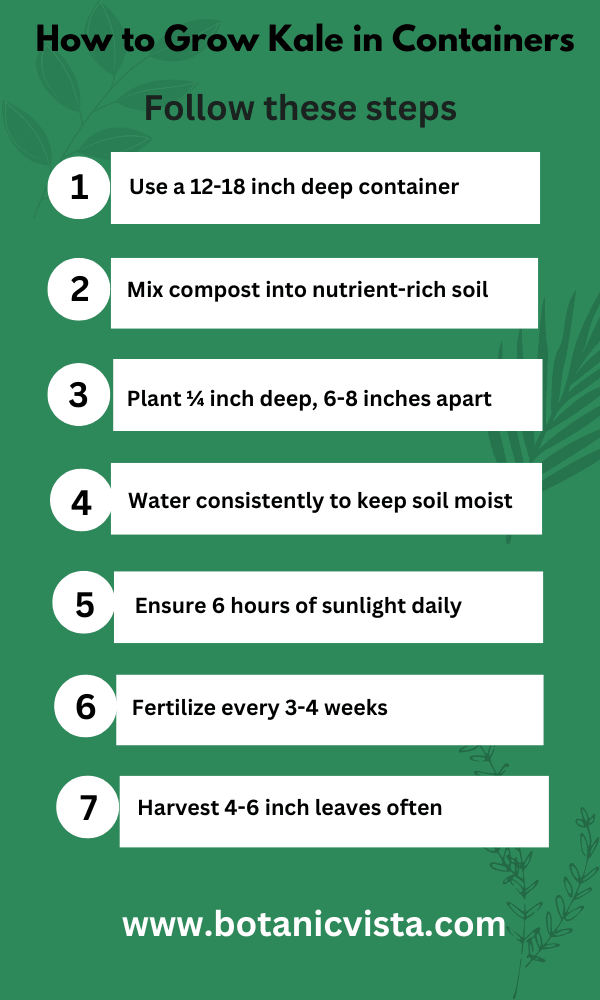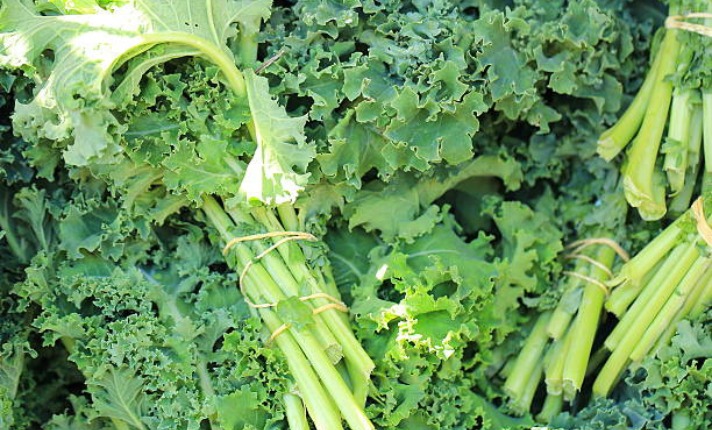Last Updated on October 11, 2024 by Jocelyn
Kale is a popular leafy vegetable celebrated for its nutritional benefits. It’s packed with vitamins, minerals, and antioxidants, making it a healthful addition to any diet. Kale is not only nutritious but also versatile – it can be used in salads, smoothies, soups, and more.
Choose a potted container with drainage holes and use potting mix for good soil. Plant kale seeds or seedlings and keep the soil moist, but not wet. Place the container in a sunny spot.
Water regularly to avoid wilted leaves. Add compost for better nutrients and transplant when needed. Re-seed every few weeks for a steady output. Kale grows well even in small spaces like a backyard or raised beds.
In this article, we will discuss how to successfully grow kale in containers. Explore essential tips for planting, caring for, and harvesting this nutrient-rich veggie.

Table of Contents
ToggleBenefits of Growing Kale in Containers
Growing kale in containers has many advantages. It makes gardening more flexible and manageable. Plus, you can enjoy fresh, home-grown kale right at your fingertips. Here are some key benefits:
| Benefits | Description |
| Saving space | Containers save space and keep your garden organized. |
| Easier placement | You can place containers wherever they fit best. |
| Fresh produce | Enjoy fresh kale ready for picking and using in recipes immediately. |
| Healthier option | Home-grown kale is often healthier and tastes better than store-bought. |
| Control over growing conditions | Control what chemicals are used and how your kale is grown. |
| Flexibility with weather | Move containers indoors during harsh weather to protect your plants. |
| Easier maintenance | Monitoring plant health and maintaining watering schedules is easier in smaller spaces. |
Choosing the Right Container
When growing kale in containers, selecting the right one is essential. Classic containers like pots are popular options. They come in many sizes and are usually affordable. Let’s discuss it in detail!
1. Types of Containers
When choosing a container for kale, you have several options:
- Pots: These are great for their portability and solid surface. They come in various sizes and are easy to find. However, they may require more frequent watering.
- Grow bags: These offer excellent air circulation for roots and are easy to move around. They are perfect if you want a flexible gardening option.
- Raised beds: These provide the most space and support the best root growth. They hold more leafy greens and allow for deeper soil depth. They are ideal if you have more room and want a long-term investment.
2. Container Size and Features
For healthy kale growth, the container size is essential. The container should be large enough to hold enough soil for the roots. This ensures that the plants get the nutrients they need. If the container is too small, the roots will not have enough space to grow, leading to poor plant health. Aim for a container that is at least 12 inches deep and wide.
Proper drainage is crucial for container gardening. Water can build up in the soil without drainage holes, causing root rot and other issues. Ensure your containers have enough holes to allow excess water to escape. This keeps the soil moist but not waterlogged, providing the best environment for your kale to grow.
Preparing the Soil Mix for Containers
To grow healthy kale in containers, start with good-quality potting soil from a trusted center. Mix in aged compost and hummus to improve water retention and nutrient content. Add crushed eggshells for calcium and organic manure or fish fertilizer for extra nitrogen. This will ensure your kale has the essential nutrients to grow strong and healthy.
Here are the key components:
- Recommended Soil Types and Amendments
Use good-quality potting soil that retains water and ensures proper drainage to avoid disease. Add aged compost for essential nutrients and improved water retention. Hummus and worm castings are beneficial for moisture and nutrient improvement.
- DIY Soil Mix Recipes
Start with potting soil, mix in compost and hummus (10 cups soil, 2 cups compost, 1 cup hummus). Add crushed eggshells for calcium and a small amount of organic manure or fish fertilizer for extra nitrogen.
- Enhancing Soil with Compost
Composting enriches soil with nutrients and improves water retention. Use a compost bin for kitchen scraps like vegetable peels and coffee grounds. Apply a thin layer of compost monthly to keep soil nutritious.
- Fertilizer Options and Application
Organic fertilizers like compost, manure, and fish fertilizers are safe and improve soil health. Synthetic fertilizers like Osmocote provide a balanced mix of nutrients. Use fertilizers sparingly and as directed to avoid harming your plants.
Step-by-Step Guide to Growing Kale in Containers
Growing kale in containers is an easy way to enjoy fresh, homegrown greens year-round. Whether you have a balcony, patio, or just a sunny spot in your garden, you can successfully grow kale with the right techniques.
Ready to learn the secrets to a bountiful kale harvest? Follow these steps to ensure your kale growth in its container garden.
Choosing the Right Container
Kale grows well in containers that are at least 0.5 m in diameter. Make sure there is enough space for the roots. A container with a diameter of 12 inches (30.5 cm) works well.
Selecting the Soil
Use good quality potting soil. Kale prefers rich, well-draining soil with a pH of 6.0-7.0.
Planting the Seeds
Plant kale seeds after the danger of frost has passed. Seedlings can also be used. Make a hole with your finger or a pencil, place the seed, and cover it lightly with soil. Pat down the soil gently.
Watering Techniques
Keep the soil moist but not waterlogged. Water deeply and slowly, ensuring it goes an inch deep. Adjust the frequency of watering based on weather conditions and plant growth.
Sunlight Requirements
Kale needs 6 hours of direct sun each day. Place the container in a sunny location, like a south-facing balcony or patio.
Fertilizing
Add vegetable compost or Plantura Organic Tomato & Vegetable Compost to provide essential nutrients. This helps the plants grow strong and healthy.
Preventing Pests and Diseases
Avoid crowded planting to reduce the risk of disease and pests. Keep an eye out for holes in the leaves, which may indicate pest problems.
Harvesting
Kale can be harvested using the cut-and-come-again method. Leaves can be picked throughout the season. Always leave a few leaves so the plant can continue to grow.
Using Drainage Material
To prevent root rot, ensure the container has good drainage. Use materials like Coconut coir, broken pottery, or stones at the bottom of the container.
Ensuring Plant Health
Choose high-quality seeds from a reputable source. This ensures strong plants that are less susceptible to disease and pests.
Transplanting Seedlings
When transplanting, be careful to avoid transplant shock. Remove the seedling gently, keeping the roots intact. Place it in a hole and cover it with soil, ensuring no air pockets.
Harvesting and Storing Kale
When your kale is grown and ready, it’s time to harvest. Kale is usually harvested at maturity, but the general size of the leaves depends on your plant.

- Identifying the Right Time to Harvest
Look for signs that kale is ready to pick. The bottom leaves are smaller and the upper leaves are big and nutrient-rich. Use your green thumb to decide when to pick.
- Harvesting Methods
Use proper techniques to ensure your hard-earned yield lasts. Pick leaves from the bottom upward to keep continuous growth. Remove any unsightly flowering plants.
- Storing Fresh Kale
Thoroughly rinse your fresh kale under running water. Pat dry with a clean towel or paper towel. Wrap loosely in a damp kitchen cloth and place in an open plastic bag with air holes in the fridge’s crisper drawer. This keeps your kale fresh for longer.
Want to grow more vegetables in pots/containers? Check out my guides:
- Growing Green Beans in Containers
- How to Grow Lettuce in a Pot
- Growing Cabbage in Containers
- Growing Radishes in Pots
Care Tips for Potted Kale
Growing kale in containers is a great way to have fresh greens at home. With the right care, your kale can grow well in pots. Below is a table with essential tips to ensure your kale stays healthy and productive.
| Care Tip | Details |
| Soil | Use rich soil with a pH of 6.5-6.8. |
| Temperature | Ideal temps are 55-75℉. Avoid temps above 75℉ and below 40℉. |
| Planting | Start seeds indoors in spring at ¼ inch deep. Sprouts appear in 7-10 days. |
| Watering | Keep soil moist with 1-1 ½ inches of water per week. |
| Fertilizing | Use veggie fertilizer with NPK 8-4-4 once a month. |
| Pests | Watch for Aphids, Flea Beetles, and Cabbage Worms. |
| Harvesting | Use scissors to cut outermost leaves every week. |
| Mulching | Add straw, compost, pine needles, or bark to keep roots cool and retain moisture. |
| Varieties | Try Lacinato, Dwarf Blue Curled, Red Russian, and Redbor. |
| Light | Ensure at least 6 hours of sun per day, but can tolerate some shade. |
| Growing Season | Best grown in spring and autumn. Can tolerate some frost. |
FAQ’s
Q: Does Kale Grow Well in Containers?
A: Kale grows well in containers if you choose one at least 10+ inches deep and wide. Ensure enough space of 18-24 inches between plants for vigorous growth. Place the container in a sunny space to help the deep-rooted plants grow successfully.
Q: How Do You Cut Kale So It Continues to Grow?
A: Gently grip the leaf close to the base of the stem and snip it off with sharp shears. Twist gently where the leaf meets the stem until it breaks off. This makes the plant continue growing.
Q: How Many Times Can You Harvest Kale?
A: You can get several harvests from one kale plant. Kale grows well in summer and even in light snow.
Q: What Is the Lifespan of a Kale Plant?
A: Kale plants are biennial, lasting up to two years with less maintenance than other plants like lettuce or spinach. This makes them a great option for gardeners.
Q: How Many Kale Plants per Container?
A: For kale in containers, plant one or two kale plants per pot. This gives each plant enough space to grow well. Use a container that is at least 12 inches wide to support healthy growth.
Conclusion
Growing kale in containers is a great way to enjoy fresh greens. Pick a container that suits your space and fill it with a nutrient-rich soil mix. Kale grows best in cool weather and shady areas.
Plant seeds in moist soil and use row covers to keep pests away. With regular care and some patience, you’ll get a bountiful harvest of delicious kale.
Starting your container garden allows you to enjoy fresh leafy greens from home. With a bit of effort, you’ll appreciate the taste of your own kale and the satisfaction of growing it yourself!

